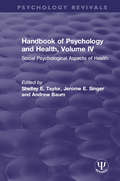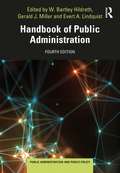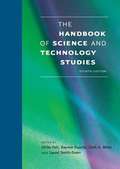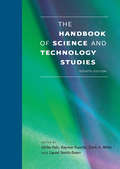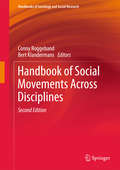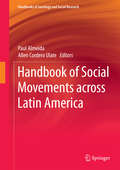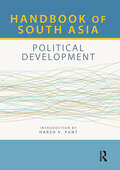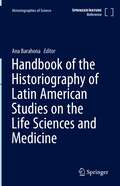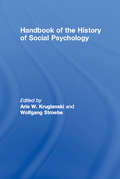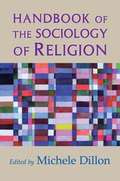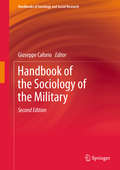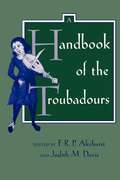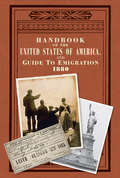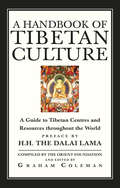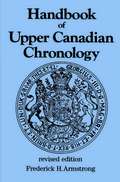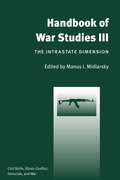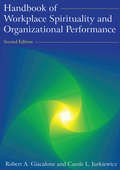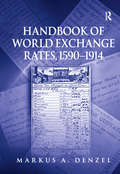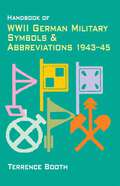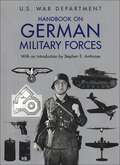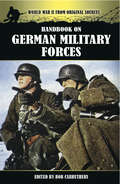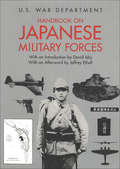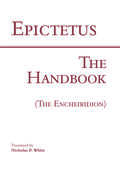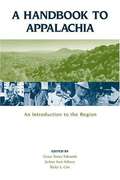- Table View
- List View
Handbook of Psychology and Health, Volume IV: Social Psychological Aspects of Health (Psychology Revivals)
by Andrew Baum; Shelley E. Taylor; Jerome E. SingerOriginally published in 1984, the study of psychological aspects of health was a rapidly expanding enterprise. Most of the contributors to this volume were trained as social psychologists or by social psychologists. Some have been more applied in their focus or on the edge of several fields. All, however, share a common approach, focusing on the individual as he or she is buffeted about by social forces and copes with these forces. All consider situational and psychological factors in the determination of behavior, emotion, or cognition and all apply their expertise to the study of health-related issues. The grouping of the chapters in this volume by the authors’ subspecialty, social psychology, is a somewhat unconventional method of clustering. Ordinarily, the materials presented here would be published in journals or texts concerned with behavior or psychosocial in health and medicine, or in specialty publications dealing with a particular disease or health issue. That clustering of articles is functional in providing information to those most likely to utilize it, but it diffuses the origin and background of the studies. These chapters speak to the diversity of health issues that are amenable to successful social psychological analysis.
Handbook of Public Administration: Theory, Politics, And Methods (Public Administration and Public Policy #1)
by W. Bartley Hildreth Gerald J. Miller Evert A. LindquistPublic administration as a field of study finds itself in the middle of a fluid environment. The very reach and complexity of public administration has been easy to take for granted, easy to attack, and difficult to explain, particularly in the soundbite and Twitter-snipe media environment. Not only has the context for the discipline changed, but the institutions of public administration have adapted and innovated to deliver services to the public and serve those in power while becoming increasingly complex themselves. Has public administration evolved? And what new lines of research are critical for effective policy and delivery of programs and public services while preserving foundational principles such as the rule of law and expert institutions? This Handbook of Public Administration sheds light for new researchers, doctoral students, scholars, and practitioners interested in probing modern public administration’s role in solving major challenges facing nations and the world. This fourth edition recognizes that the scholarship of public administration must reflect the diverse influence of an international orientation, embracing public administration issues and practices in governance systems around the world, and illustrating just how practice can vary across jurisdictions. Every section identifies foundational principles and issues, shows variation in practice across selected jurisdictions, and identifies promising avenues for research. Each chapter revisits enduring themes and tensions, showing how they persist, along with new challenges and opportunities presented by digital technology and contemporary political realities. The Handbook of Public Administration, Fourth Edition provides a compelling introduction to and depiction of the contemporary realities of public administration, and it will inspire new avenues of inquiry for the next generation of public administration researchers.
The Handbook of Science and Technology Studies
by Clark A. Miller Laurel Smith-Doerr Rayvon Fouché Ulrike FeltScience and Technology Studies (STS) is a flourishing interdisciplinary field that examines the transformative power of science and technology to arrange and rearrange contemporary societies. The Handbook of Science and Technology Studies provides a comprehensive and authoritative overview of the field, reviewing current research and major theoretical and methodological approaches in a way that is accessible to both new and established scholars from a range of disciplines. This new edition, sponsored by the Society for Social Studies of Science, is the fourth in a series of volumes that have defined the field of STS. It features 36 chapters, each written for the fourth edition, that capture the state of the art in a rich and rapidly growing field. One especially notable development is the increasing integration of feminist, gender, and postcolonial studies into the body of STS knowledge. The book covers methods and participatory practices in STS research; mechanisms by which knowledge, people, and societies are coproduced; the design, construction, and use of material devices and infrastructures; the organization and governance of science; and STS and societal challenges including aging, agriculture, security, disasters, environmental justice, and climate change.
The Handbook of Science and Technology Studies, fourth edition (The\mit Press Ser.)
by Ulrike Felt Rayvon Fouché Clark Miller Laurel Smith-DoerrThe fourth edition of an authoritative overview, with all new chapters that capture the state of the art in a rapidly growing field.Science and Technology Studies (STS) is a flourishing interdisciplinary field that examines the transformative power of science and technology to arrange and rearrange contemporary societies. The Handbook of Science and Technology Studies provides a comprehensive and authoritative overview of the field, reviewing current research and major theoretical and methodological approaches in a way that is accessible to both new and established scholars from a range of disciplines. This new edition, sponsored by the Society for Social Studies of Science, is the fourth in a series of volumes that have defined the field of STS. It features 36 chapters, each written for the fourth edition, that capture the state of the art in a rich and rapidly growing field. One especially notable development is the increasing integration of feminist, gender, and postcolonial studies into the body of STS knowledge. The book covers methods and participatory practices in STS research; mechanisms by which knowledge, people, and societies are coproduced; the design, construction, and use of material devices and infrastructures; the organization and governance of science; and STS and societal challenges including aging, agriculture, security, disasters, environmental justice, and climate change.
Handbook of Social Movements Across Disciplines
by Conny Roggeband Bert KlandermansThis book aims to revisit the interdisciplinary roots of social movement studies. Each discipline raises its own questions and approaches the subject from a different angle or perspective. The chapters of this handbook are written by internationally renowned scholars representing the various disciplines involved. They each review the approach their sector has developed and discuss their disciplines' contributions and insights to the knowledge of social movements. Furthermore, each chapter addresses the "unanswered questions" and discusses the overlaps with other fields as well as reviewing the interdisciplinary advances so far.
Handbook of Social Movements across Latin America
by Paul Almeida Allen Cordero UlateThis handbook covers social movement activities in Latin American countries that have had profound consequences on the political culture of the region. It examines the developments of the past twenty years, such as a renewed upswing in popular mobilization, the ending of violent conflicts and military governments, new struggles and a relatively more democratic climate. It shows that, from southern Chiapas to Argentina, social movements in the 1990s and especially in the 2000s, have reached new heights of popular participation. There is a lack of research on the politics of this region in the contemporary era of globalization, this volume partially fills the void and offers a rich resource to students, scholars and the general public in terms of understanding the politics of mass mobilization in the early twenty-first century. The contributors each address social movement activity in their own nation and together they present a multidisciplinary perspective on the topic. Each chapter uses a case study design to bring out the most prominent attributes of the particular social struggle(s), for instance the main protagonists in the campaigns, the grievances of the population and the outcomes of the struggles. This Handbook is divided into seven substantive themes, providing overall coherence to a broad range of social conflicts across countries, issues and social groups. These themes include: 1) theory of Latin American social movements; 2) neoliberalism; 3) indigenous struggles; 4) women's movements; 5) movements and the State; 6) environmental movements; and 7) transnational mobilizations.
Handbook of South Asia: Political Development
This Handbook brings together essays that introduce the reader to the key issues in South Asian political development. Written by experts in their respective areas, the essays explore key aspects of political economy, political and economic change, and the complex diplomatic and security challenges of individual countries and the region as a whole. Essays discuss topics as wide-ranging as China’s growing reach in South Asia, political Islam, SAARC and water politics through the region. This well-researched Handbook is an essential reference tool for students and scholars of Political Science, International Relations and South Asian studies.With an introduction by Harsh V Pant.
Handbook of the Historiography of Latin American Studies on the Life Sciences and Medicine (Historiographies of Science)
by Ana BarahonaThis volume provides a definitive assessment of the historiography of the life sciences and medicine in Latin America. It makes historiographic work available for new scholars to join the field and for graduate students and other scholars new to the history of science in Latin America, by means of meaningful and original contributions.This volume brings transnational analysis to the center of global historiographical discussions. It seeks to contribute both empirically and theoretically to the fields of History of Science and Science and Technology Studies (STS) in Latin America, to account for how the knowledge produced in developing countries is part of international knowledge as it circulates in transnational collaborative networks. The volume consists of articles written by experienced, expert authors who expose the lines of ongoing research in the history of life sciences and medicine in Latin America in order to provide an overview of the multiplicity of analytic frameworks and perspectives in a way that allows them to be contrasted with each other. Some of the topics discussed include Asymmetrical networks of collaboration, Circulation of Knowledge, Conceptual History, History and Art, History of Race, Gender and the like, and many more.
Handbook of the History and Philosophy of Mathematical Practice
by Bharath SriramanThe purpose of this unique handbook is to examine the transformation of the philosophy of mathematics from its origins in the history of mathematical practice to the present. It aims to synthesize what is known and what has unfolded so far, as well as to explore directions in which the study of the philosophy of mathematics, as evident in increasingly diverse mathematical practices, is headed. Each section offers insights into the origins, debates, methodologies, and newer perspectives that characterize the discipline today. Contributions are written by scholars from mathematics, history, and philosophy – as well as other disciplines that have contributed to the richness of perspectives abundant in the study of philosophy today – who describe various mathematical practices throughout different time periods and contrast them with the development of philosophy. Editorial Advisory Board Andrew Aberdein, Florida Institute ofTechnology, USA Jody Azzouni, Tufts University, USA Otávio Bueno, University of Miami, USA William Byers, Concordia University, Canada Carlo Cellucci, Sapienza University of Rome, Italy Chandler Davis, University of Toronto, Canada (1926-2022) Paul Ernest, University of Exeter, UK Michele Friend, George Washington University, USA Reuben Hersh, University of New Mexico, USA (1927-2020) Kyeong-Hwa Lee, Seoul National University, South Korea Yuri Manin, Max Planck Institute for Mathematics, Germany (1937-2023) Athanase Papadopoulos, University of Strasbourg, France Ulf Persson, Chalmers University of Technology, Sweden John Stillwell, University of San Francisco, USA David Tall, University of Warwick, UKThis book with its exciting depth and breadth, illuminates us about the history, practice, and the very language of our subject; about the role of abstraction, ofproof and manners of proof; about the interplay of fundamental intuitions; about algebraic thought in contrast to geometric thought. The richness of mathematics and the philosophy encompassing it is splendidly exhibited over the wide range of time these volumes cover---from deep platonic and neoplatonic influences to the most current experimental approaches. Enriched, as well, with vivid biographies and brilliant personal essays written by (and about) people who play an important role in our tradition, this extraordinary collection of essays is fittingly dedicated to the memory of Chandler Davis, Reuben Hersh, and Yuri Manin.---Barry Mazur, Gerhard Gade University Professor, Harvard UniversityThis encyclopedic Handbook will be a treat for all those interested in the history and philosophy of mathematics. Whether one is interested in individuals (from Pythagoras through Newton and Leibniz to Grothendieck), fields (geometry, algebra, number theory, logic, probability, analysis), viewpoints (from Platonism to Intuitionism), or methods (proof, experiment, computer assistance), the reader will find a multitude of chapters that inform and fascinate.---John Stillwell, Emeritus Professor of Mathematics, University of San Francisco; Recipient of the 2005 Chauvenet PrizeDedicating a volume to the memory of three mathematicians – Chandler Davis, Reuben Hersh, and Yuri Manin –, who went out of their way to show to a broader audience that mathematics is more than what they might think, is an excellent initiative. Gathering authors coming from many different backgrounds but who are very strict about the essays they write was successfully achieved by the editor-in-chief. The result: a great source of potential inspiration!---Jean-Pierre Bourguignon; Nicolaas Kuiper Honorary Professor at the Institut des Hautes Études Scientifiques
Handbook of the History of Social Psychology
by Arie W. Kruglanski Wolfgang StroebeFor the first time in the history of social psychology, we have a handbook on the history of social psychology. In it, leading luminaries in the field present their take on how research in their own domains has unfolded, on the scientists whose impact shaped the research agendas in the different areas of social psychology, and on events, institutions and publications that were pivotal in determining the field’s history. Social psychology’s numerous subfields now boast a rich historical heritage of their own, which demands special attention. The Handbook recounts the intriguing and often surprising lessons that the tale of social psychology’s remarkable ascendance has to offer. The historical diversity is the hallmark of the present handbook reflecting each of this field’s domains unique evolution. Collectively, the contributions put a conceptual mirror to our field and weave the intricate tapestry of people, dynamics and events whose workings combined to produce what the vibrant discipline of social psychology is today. They allow the contemporary student, scholar and instructor to explore the historical development of this important field, provide insight into its enduring aims and allow them to transcend the vicissitudes of the zeitgeist and fads of the moment. The Handbook of the History of Social Psychology provides an essential resource for any social psychologist’s collection.
Handbook of the Sociology of Religion
by Michele DillonThis Handbook showcases research and thinking in the sociology of religion. The contributors, all active writers and researchers in the area, provide original chapters focusing on select aspects of their own engagement with the field. Aimed at students and scholars who want to know more about the sociology of religion, this handbook also provides a resource for sociologists in general by integrating broader questions of sociology (e.g. demography, ethnicity, life course, inequality, political sociology) into the analysis of religion. Broadly inclusive of traditional research topics (modernity, secularization, politics) as well as newer interests (feminism, spirituality, faith based community action), this handbook illustrates the validity of diverse theoretical perspectives and research designs to understanding the multi-layered nature of religion as a sociological phenomenon.
Handbook of the Sociology of the Military (Handbooks Of Sociology And Social Research Ser.)
by Marina Nuciari Giuseppe CaforioThis new edition of the volume is presented on the wave of the success which had its first edition (2003). It is entirely updated to the current situation of the disciplines covered, and expanded with particular regard to the new missions, that have become the main challenge for the armed forces in these first decades of the new millennium, with new insights to technological development toward so-called cyborg warriors, new forms of leadership and changes in soldier's identity and organisational culture. It is compiled of documents coming from various researchers at universities around the world as well as military officers devoted to the sector of study. Covered in this volume is a historical excursus of studies prior to contemporary research, interpretive models and theoretical approaches developed specifically for this topic, civic-military relations including issues surrounding democratic control of the armed forces, military culture, professional training, conditions and problems of minorities in the armed forces, an examination of the structural change within the military over the years including new duties and functions following the Cold War.
A Handbook of the Troubadours (Center for Medieval and Renaissance Studies, UCLA #26)
by F. R. Akehurst Judith M. DavisThis book is a reference volume and a digest of more than a century of scholarly work on troubadour poetry. Written by leading scholars, it summarizes the current consensus on the various facets of troubadour studies.Standing at the beginning of the history of modern European verse, the troubadours were the prime poets and composers of the twelfth and thirteenth centuries in the South of France. No study of medieval literature is complete without an examination of the courtly love which is celebrated in the elaborately rhymed stanzas of troubadour verse, creations whose words and melodies were imitated by poets and musicians all over medieval Europe.The words of about 2,500 troubadour songs have survived, along with 250 melodies, and all have come under intense scholarly scrutiny. This Handbook brings together the fruits of this scrutiny, giving teachers and students an overview of the fundamental issues in troubadour scholarship. All quotations are given in the original Old Occitan and in English. The editors provide a list of troubadour editions and an index, and each chapter includes a list of additional readings.
Handbook of the United States of America, 1880
by Lp BrockettAmerica's "golden door" welcomed a huge wave of European immigrants between the 1880s and the 1920s. Millions passed through the gateway of the Statue of Liberty and Ellis Island on their way to becoming Americans, and The Handbook of the United States is an authentic reproduction of one of the immigrants' most trusted resources-- a complete guide to the USA, including everything from the pay-rates of various trades to amusing statistics about what Americans ate, drank, and manufactured. Once the tool that helped thousands of Irish, Italian and Jewish immigrants use their drive and industriousness to succeed, today it provides new insights into the extraordinary circumstances of the immigrant experience and the new arrivals' remarkable contribution to making America a great global power.
A Handbook Of Tibetan Culture: A Guide To Tibetan Centres And Resources Throughout The World
by Graham ColemanHandbook of Upper Canadian Chronology
by Frederick H. ArmstrongA revised and greatly expanded edition of this important and long out of print reference book on Upper Canada to 1841. Similar in format to A Handbook of British Chronology, this work is a listing of all legislative councilors, and assemblymen, all officials, dates of all parliaments, and judges and court officials. It gives as well, a complete picture of local government: legislation relating to local territorial authorities, lists of counties, districts, cities and townships, and all major officials. The new edition includes the basic population statistics, a completely revised list of the events of the War of 1812 and new lists of the events of the Rebellions of 1837 and the Patriot Raids that followed the next year, tables of the provincial and British statutes relating to the incorporation of businesses, the officers of the major Upper Canadian corporations, a complete list of post office officials and post offices, and a list of provincial surveyors, and the major disasters.
Handbook of War Studies III: The Intrastate Dimension
by Manus I. MidlarskyHandbook of War Studies III is a follow-up to Handbook of War Studies I (1993) and II (2000). This new volume collects original work from leading international relations scholars on domestic strife, ethnic conflict, genocide, and other timely topics. Special attention is given to civil war, which has become one of the dominant forms - if not the dominant form - of conflict in the world today.
Handbook of Workplace Spirituality and Organizational Performance
by Robert A Giacalone Carole L. JurkiewiczAn explanation of how and why the economic downturn of 2007 became the Great Recession of 2008 and 2009. It explores the root causes of the cycle of boom and bust of the economy. It describes social equity in terms of its arguments and claims in political, economic, and social circumstances.
Handbook of World Exchange Rates, 1590–1914
by Markus A DenzelAs a world economy emerged from the 16th-17th centuries onwards, a global cashless payment system arose. This had its base in Europe, first in Italy, then in the rising regions of the north-west, with Amsterdam and then London as the central financial market. The mutual quotation of exchange rates, which provide the data tabulated and analysed here, mark the integration into a global network of all areas with significant economic potential. The primary aim of this book is to provide a compact account of the exchange rates in all these financial markets, from the late 16th century up to the First World War. This makes possible an instant conversion between the major world currencies at nearly any date within that period, while the important introduction provides the explanation and context of developments. The present handbook therefore serves as an invaluable resource for those concerned with all aspects of commercial and financial history.
Handbook of WWII German Military Symbols & Abbreviations 1943-45
by Terrence BoothA comprehensive reference guide to German military symbols used on documents, maps, orders of battle and elsewhere.To the uninitiated, German military symbols can appear indecipherable. Yet understanding their meaning is essential to any serious research of the WWII German Armed Forces. This book provides a clear and comprehensive reference to these symbols, as seen in photos, tables of organization and maps for the period May 1943 onwards. The first two parts of the book feature an overview of how the German Armed Forces used the symbols in the field. Parts III, IV and V deal with specific forms and categories of symbols used. The format provides an image of each symbol, accompanied by the relevant German term and its English translation, along with any pertinent information that will aid the reader’s understanding of the symbol and the unit that it represented. The final part of the book, containing a list of over 500 abbreviations and their German terms, supplemented by English translations, should prove invaluable to any reader who has more than a passing interest in the Second World War German Armed Forces.
Handbook on German Military Forces
by Stephen E. Ambrose U.S. War Department David I. NorwoodIn March, 1945, the U.S. War Department issued a restricted document called Handbook on German Military Forces. The restricted classification was removed in 1953, but the handbook has until now remained virtually unknown. The book is a massive compendium of information on every aspect of Hitler's forces. It gives credence to the contention that by 1945 U.S. Army Chief of Staff George C. Marshall may have known more about the German military than did Hitler himself. Exceptionally well organized and exhaustively detailed, the handbook examines German military personnel from the lowest levels to the High Command. It describes the Wehrmacht's administrative structure, unit organization, field tactics, fortification and defense systems, weapons and other equipment, and uniforms and insignia. Moreover, it presents this abundance of information in a manner that is remarkable for its depth and clarity. The book contains an astute analysis of the psychology of the German soldier and charts the ways in which the attitudes of Hitler's men changed over the course of the war. It also considers the strengths and weaknesses of the German weapons systems, describes how Allied soldiers could make use of captured weapons, and offers advice on how Allied military personnel might avoid being captured themselves. Hundreds of tables, organizational charts, and illustrations, some in color, add further value to the book. Handbook on German Military Forces will prove indispensable to scholars of World War II as well as to all devotees of military history.
Handbook on German Military Forces: Handbook On German Military Forces (World War II From Original Sources)
by Bob CarruthersThe Handbook On German Military Forces is an indispensable primary reference source for historians and enthusiasts. In 1945 the Allies were still engaged in bitter fighting against stiff resistance from the German armies in the west. The US War Department was determined to do its best to equip the US forces fighting the Germans in the field with as much knowledge as possible. March 1945 saw the issue of an astonishing document entitled the Handbook On German Military Forces. This was a truly remarkable work of intelligence gathering which formed a vast compendium of all the relevant knowledge amassed on the German Wehrmacht.Amazingly accurate and comprehensive, the Handbook ran to over six hundred pages and was designed to equip commanders in the field with everything they were likely to need to know about the German forces. The Handbook remained classified until 1953 and then slipped into obscurity.This new paperback reprint rescues this great work from obscurity, covering the psychology, organisation, tactics and operational aspects of the German forces. The weapons, machines, aircraft and uniforms of the German forces are also documented within the Handbook.The Handbook On German Military Forces is a fascinating primary reference source for historians and enthusiasts alike, providing an invaluable insight into the detail of the German Army which is still an unrivaled source of information today.
Handbook on Japanese Military Forces
by U.S. War Department Jeffrey Ethell David IsbeyIn 1944 the U.S. Army published this manual for its officers in the Pacific Theater an expanded version of the original 1942 manual of the same name--and ever since, it has been the best single reference source on the wartime Japanese military available in the English language. By 1944, the army had had time to assess its enemy closely and was coming to understand him, and its vast knowledge was distilled into the handbook. The handbook details the Japanese military system, field organization, tactics, and weapons and equipment, and the strengths and weaknesses that resulted from them. Extensively illustrated, it contains sections on the Japanese special forces, the military police, uniforms and insignia, and conventional signs and abbreviations. It covers, besides the army, the Japanese Air Service, with emphasis on its tactics and organization. Issued to officers for briefings and periodically updated, the handbook's purpose was to assist in the winning of the war, and thus it strove to be absolutely reliable for its users in combat. It was compiled by a team of officers who integrated the research of others, and it contains information provided by the U.S. Marines and also by British and Australian intelligence. Packed with information, it is a major primary source that military historians and World War II buffs will find fascinating.
The Handbook (The Encheiridion)
by Epictetus Nicholas P. WhiteFrom the Introduction: "Stoic philosophy, of which Epictetus (c. a.d. 50-130) is a representative, began as a recognizable movement around 300 b.c. Its founder was Zeno of Cytium (not to be confused with Zeno of Elea, who discovered the famous paradoxes). He was born in Cyprus about 336 b.c., but all of his philosophical activity took place in Athens. For more than 500 years Stoicism was one of the most influential and fruitful philosophical movements in the Graeco-Roman world. The works of the earlier Stoics survive only in fragmentary quotations from other authors, but from the Renaissance until well into the nineteenth century, Stoic ethical thought was one of the most important ancient influences on European ethics, particularly because of the descriptions of it by Cicero, through surviving works by the Stoics Seneca, Marcus Aurelius, and also Epictetus--and also because of the effect that it had had in antiquity, and continued to have into the nineteenth century, on Christian ethical views. Nowadays an undergraduate or graduate student learning about ancient philosophy in a university course may well hear only about Plato and Aristotle, along perhaps with the presocratics; but in the history of Western thought and education this situation is somewhat atypical, and in most periods a comparable student would have learned as much or more about Stoicism, as well as two other major ancient philosophical movements, Epicureanism and Scepticism. In spite of this lack of explicit acquaintance with Stoic philosophers and their works, however, most students will recognize in Epictetus various ideas that are familiar through their effects on other thinkers, notably Spinoza, in our intellectual tradition."
A Handbook to Appalachia: An Introduction to the Region
by Grace Tomey Edwards Noann Aust Asbury Ricky L. CoxReference work introducing various aspects of the Appalachian region including geography, history, the arts, etc.
